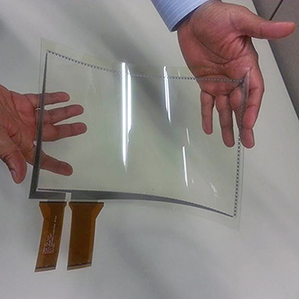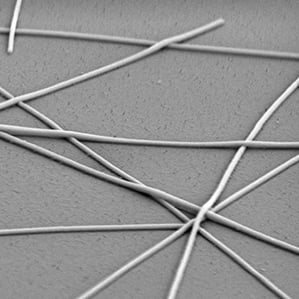A lire sur: http://www.technologyreview.com/news/523221/nanomaterials-could-enable-large-flexible-touch-screens/
3M’s new silver nanowire films could lead to large, interactive, and ultimately flexible displays.
Katherine Bourzac on January 3, 20143M’s new silver nanowire films could lead to large, interactive, and ultimately flexible displays.
WHY IT MATTERS
Today’s touch screens are rigid and limited in size because of the brittle materials required to make them.
 Flexible feel:Conductive transparent films using nano materials developed by Cambrios Technologies make it possible to make flexible, large touch screen displays.
3M will begin selling flexible transparent conductive films made of silver nanowires for use in touch screens. These nanomaterials could enable wider adoption of large touch screens for interactive signs, displays, and personal computers. And the flexible films may come to be used in future foldable, curvy personal electronics, too.
The St. Paul, Minnesota, company will make the films using silver nanowires produced by Cambrios, a Sunnyvale, California, startup founded in 2004 by two materials scientists: Evelyn Hu, now at Harvard University, and MIT’s Angela Belcher. The company’s silver nanowires are a few nanometers in diameter and a few micrometers long, and come suspended in inks. The inks can be spread out onto a surface to make sparse films. The silver wires are designed to spread in random networks, like nano pick-up sticks, so that they won’t cause a pattern that’s distracting to the eye—an irritating problem that plagued earlier metal-mesh touch screens.
Flexible feel:Conductive transparent films using nano materials developed by Cambrios Technologies make it possible to make flexible, large touch screen displays.
3M will begin selling flexible transparent conductive films made of silver nanowires for use in touch screens. These nanomaterials could enable wider adoption of large touch screens for interactive signs, displays, and personal computers. And the flexible films may come to be used in future foldable, curvy personal electronics, too.
The St. Paul, Minnesota, company will make the films using silver nanowires produced by Cambrios, a Sunnyvale, California, startup founded in 2004 by two materials scientists: Evelyn Hu, now at Harvard University, and MIT’s Angela Belcher. The company’s silver nanowires are a few nanometers in diameter and a few micrometers long, and come suspended in inks. The inks can be spread out onto a surface to make sparse films. The silver wires are designed to spread in random networks, like nano pick-up sticks, so that they won’t cause a pattern that’s distracting to the eye—an irritating problem that plagued earlier metal-mesh touch screens.
The films are mostly empty space, so they’re transparent. But the nanowires and the ink are formulated so that these films are still highly conductive. The company claims that electrodes made from its ink are more conductive and transparent than the most commonly used touch screen material. Cambrios also says the material can be rolled and unrolled over 100,000 times without breaking.
 Random order: An electron microscope shows the random placement of silver nanowires that are spread out to make the transparent conductive films.
Random order: An electron microscope shows the random placement of silver nanowires that are spread out to make the transparent conductive films.
That’s in contrast to today’s touch screens, which are made of brittle indium tin oxide films. These conventional touch screens have made new kinds of interfaces possible in small devices like smartphones and tablets. But touch screens using the current materials are limited in size and design. The electrical signal has to travel from the touch all the way to the edge of the display, where it’s picked up. If the signal has to go very far, it becomes too weak, and the screen isn’t responsive enough. To make indium tin oxide electrodes more conductive and boost that signal, manufacturers can lay on thicker films, but that makes the display less transparent. The new nano films could also be beneficial for conventional rigid displays. Indium tin oxide is deposited onto sheets of glass in vacuum chambers; half the material lands not on the glass but on the inner surfaces of the chamber and must be recovered and reused. The nanowire inks can be coated more efficiently and can be made on thin, flexible sheets of plastic rather than glass. 3M uses PET, the same plastic found in many water bottles. Glass is getting thinner and lighter, and touch screens built on plastic should be thinner and lighter still—a selling point for cell phone makers. 3M is not the first company to start selling a touch screen product that uses Cambrios inks. In October 2012, Cambrios announced that its inks were being used in LG’s all-in-one computer and some displays; the Cambrios materials are also found in cell phones and tablets made by NEC in Japan and Huawei in China. Supplying nanowires to 3M, however, will enable the company to get into more devices. 3M is making the touch screen films for device makers but has not yet named customers.
Aucun commentaire:
Enregistrer un commentaire